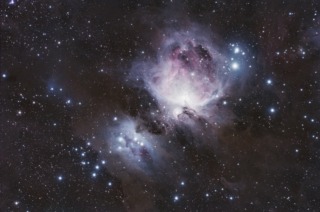
- Constellation: Orion
- Right Ascension: 05h 35m 17.3s
- Declination: −05° 23′ 28″
- Distance: 1,350 ly
The Orion Nebula or M42 is one of the brightest nebulae in the sky, visible as a "fuzzy" star in Orion's sword hanging from the belt. The Trapezium cluster named for the four brightest OB stars form a trapezoid figure ionizes and illuminates the nebula. The nebula contains hundreds of young stars and more than 700 stars associated with the cluster.
- Details
- Category: Nebulas
- Telescope: EDT 80mm Reftactor
- Camera: ZWO A071 Color
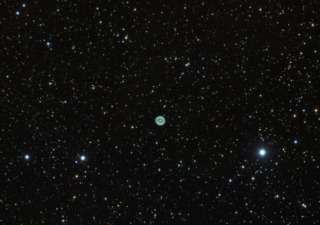
- Constellation: Camelopardalis
- Right Ascension: 04h 06m 59.39s
- Declination: +60° 55′ 14.4″
- Distance: 4000-5000 ly
Sometimes called the Oyster Nebula, NGC 1501 is a planetary nebula located in Camelopardalis (The Giraffe). The central star shed its outer layers and those layers are now illuminated by the central star. The central star is also reported to be a pulsating variable star with an extremely short period of brightness changes.
- Details
- Category: Nebulas
- Telescope: Explore Scientific 127 Refractor
- Camera: Atik 314l+
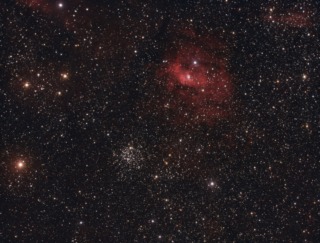
- Constellation: Cassiopeia
The Bubble Nebula or NGC 7635 is an hydrogen emission nebula with a bubble structure that is formed by stellar wind from a massive central star. Also in the field of view is the open cluster of Messier 52. M 52 is at a distance of 4,600 light years and the Bubble Nebula is a more distant 7,000 to 11,000 light years away.
- Details
- Category: Nebulas
- Telescope: EDT 80mm Reftactor
- Camera: ZWO 1600 MM
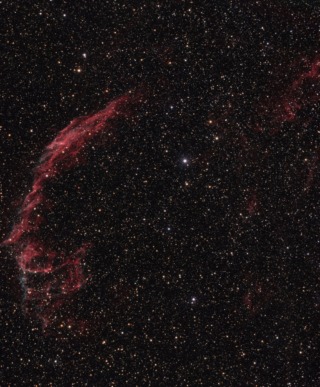
- Constellation: Cygnus
- Right Ascension: 20h 45m 38.0s
- Declination: +30° 42′ 30"
- Distance: 1,470 ly
NGC6992, or Eastern Veil Nebula, is the eastern part of a supernova remnant of a star that went supernova about 8,000 years ago. The whole object is around the diameter of 6 full Moons. Shock waves create the delicate looking structures as they encounter interstellar gas and dust.
Imaged with 80mm scope and HaRGB filters
- Details
- Category: Nebulas
- Telescope: EDT 80mm Reftactor
- Camera: ZWO 1600 MM
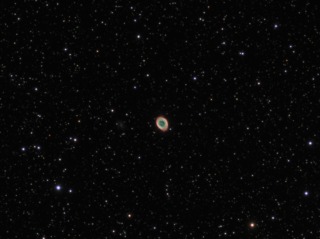
- Constellation: Lyra
- Right Ascension: 18h 53m 35.079s
- Declination: +33° 01′ 45.03″
- Distance: 2,300 ly
Messier 57 is a planetary nebula located in the constellation of Lyra. Often referred to as the Ring nebula as it resembles a small ring visually in a telescope. A planetary nebula is formed when a star in the latter stages of its life swells up into a red giant phase and the outer layers are expelled into the surrounding space as the star contracts down to a white dwarf. The ionizing radiation causes the surrounding gas to fluoresce.
Independently discovered by Charles Messier and Antoine Darquier de Pellepoix in January 1779.
Imaged with the ES127 refractor and the Atik314L+ mono camera.
Also visible in this highly stretched version are several background galaxies.
- Details
- Category: Nebulas
- Telescope: Explore Scientific 127 Refractor
- Camera: Atik 314l+
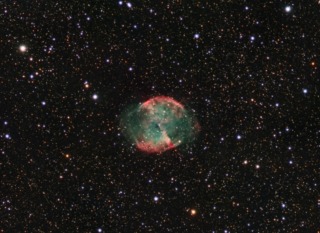
- Constellation: Vulpecula
- Right Ascension: 19h 59m 36.340s
- Declination: +22°43’16.09”
- Distance: 1,360 ly
Messier 27 or commonly called the Dumbbell Nebula or Apple Core nebula due to its appearance visually through a telescope. It is a planetary nebula which is a misnomer as it has nothing to do with planets. It is formed as a star enters it's last stages of its life as the outer layers swell out and before they dissipate out into space. The surrounding layers are ionized by the remaining hot core. The remains of the star eventually contract down into a white dwarf to slowly cool over the eons. The central white dwarf is one of the largest known white dwarfs. The estimated age of the nebula is around 14,600 years.
- Details
- Category: Nebulas
- Telescope: Explore Scientific 127 Refractor
- Camera: Atik 314l+